When I first visited Shirakawa-go, it floored me into disbelief. I wasn’t sure if I’d stepped into a portal and landed myself inside a Christmas snowglobe. That view into the valley with the thatched roof huts under the powdery snow – it’s not an easy one to forget! Luckily for you (and me) it is very real, and if you visit Japan in winter it must not be missed. Here’s how to visit Shirakawa-go next winter!
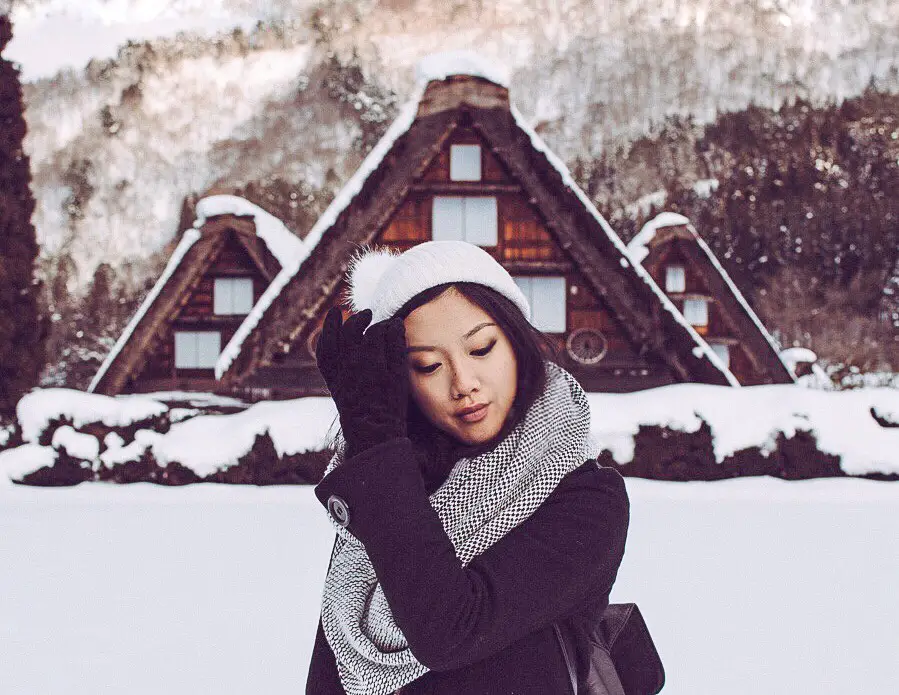
Introduction
Shiragawa-go is located in the Gifu Prefecture, an area of Japan known for being a winter destination, especially for sports enthusiasts. The Ogimachi Village is the main attraction of visiting Shiragawa-go, as it is where you’ll find the historic huts. These are known as Gassho-zukuri, and historically were used as farmhouses. The shape of the Gassho are distinct, with steep roofs built to withstand heavy snowfall, which is common in this region in winter. The shape of the huts are said to resemble the hands of a Buddhist monk in prayer. This area was listed as a UNESCO heritage site in 1995.
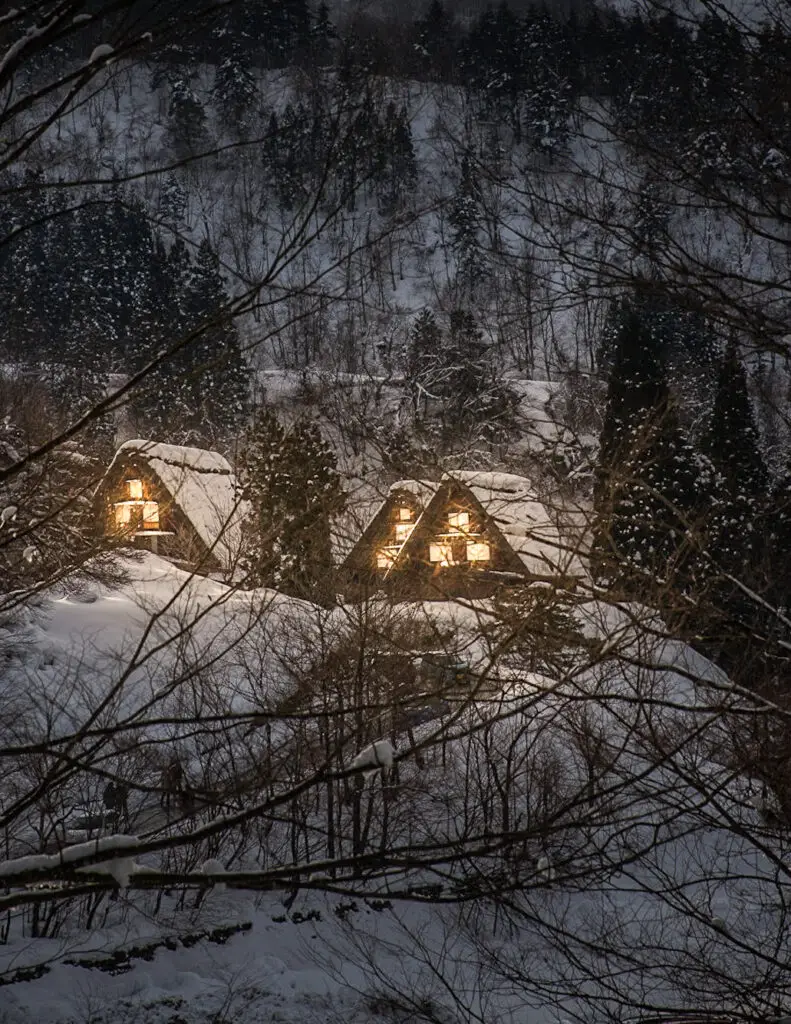
When to Go
When I lived in Japan, they highly marketed Shirakawa-go as a winter wonderland destination. There are posters all over the metro, suggesting that people visit in the colder months. The truth is it is beautiful year round.
With that said, I have visited it multiple times, bringing my friends and family here on different trips. After seeing it in warmer months and winter, I do feel that it looks the most magical is in the winter.
In Winter
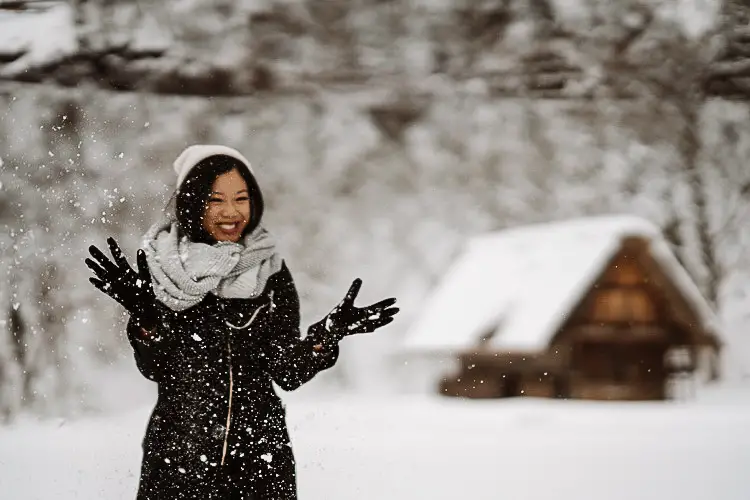
To see Shirakawa-go in the peak of winter, you should aim to visit between December and February. Generally, January and February will be colder and you’ll have thicker snow, but the weather is unpredictable.
I came once in late January and the snow was thin, and melting. I went in early December another year, and the snow was dumping.
Depending on the day, the weather can be clear skies or cloudy. It’s pretty damn cold either way, but it doesn’t seem to deter the many people who visit in this season.
It’s worth mentioning, that because winter is the most beautiful time to visit Shirakawa-go, it’s also very crowded. You will have large crowds coming hot off the tour buses each morning here. If you want to stay overnight, you should plan ahead and book well ahead of your stay.

Light up Events
One reason why it’s popular to visit Shirakawa-go in winter, is for the light up event. In winter, there are a few days a month, where they will light up the huts in the Ogimachi Village at night. It’s beautiful to see, and amazing for photography. If you want to check it out, definitely check online for the scheduled dates, as they change each year.
If you want to stay for the light up event, plan where you will stay for the evening, since you’ll be there later and the buses may not run.
Getting There
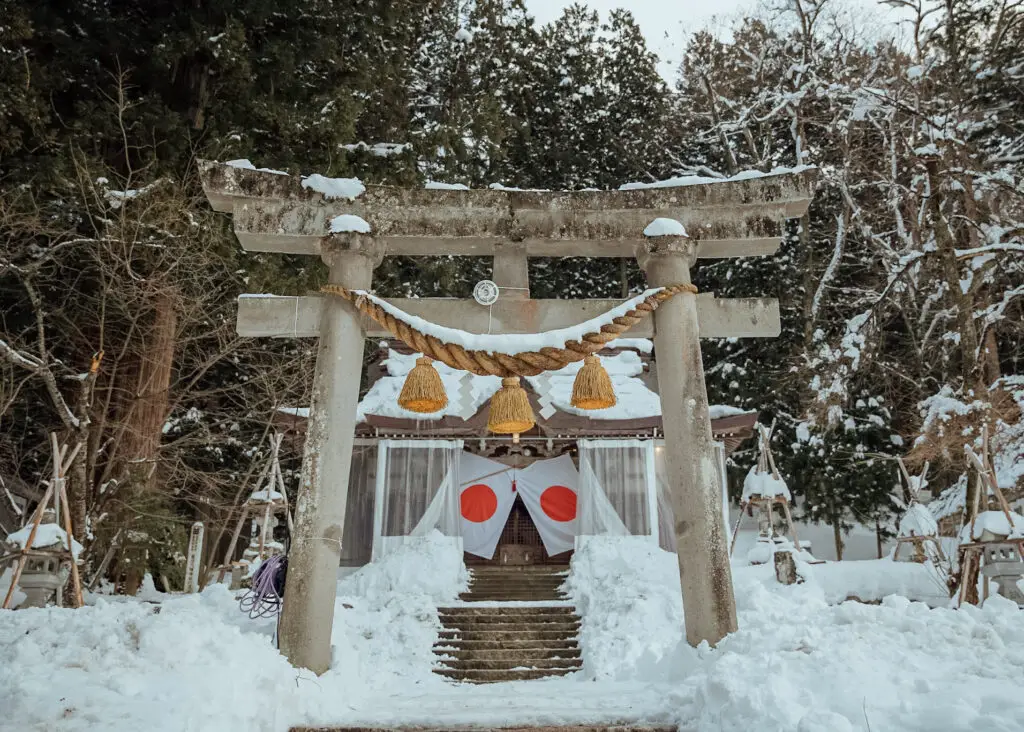
You can get to Shirakawa-go by car or by taking the train and a bus.
By Car
You can get to Shirakawa-go by car. Keep in mind, you will be likely driving through snowy conditions in this time of year.
In Japan, they don’t use or offer you tire chains. Instead when you rent your car, they will tell you that you have winter tires, which should be enough.
The roads in Japan are well managed, and we had no problems driving without chains. However, on some parts of the local roads, there could be snow and ice, especially in the morning.
To get there from Osaka takes about 5 hours, and over 6 hours from Tokyo. You should also schedule some time in for delays, especially as you get closer to Gifu, and enter the mountainous region. You’ll likely be driving slower when you reach snowy areas.
Also you should know that in Japan, there are an excessive amount of toll booths. In total, we passed at least 3, from Osaka to Shirakawa-go. We had 3 people in the car to split the costs, but otherwise it may actually be more cost effective to take the train and bus.
Each toll booth will cost anywhere from 1600 yen to 2400 yen, and you will pass them every couple hours.
By Bus
If you are a solo traveler, I highly suggest taking the train and bus to Shirakawa-go. You won’t need a car while there, unless you plan to visit the surrounding areas, and even then there are public trannsportation options.
From Osaka
From Osaka you can take the Shinkansen (bullet train) from Shin-Osaka Station to Nagoya Station. There are frequent trains on this route, leaving multiple times an hour.
From Nagoya Station you’ll need to transfer to the Meitetsu BC Bus Stop. If you feel confused about where that is screenshot a picture of it on google maps, and show someone working at the station. Japanese people usually don’t speak English, but they are happy to help.
From the bus stop, you’ll need to get on the Gifu Bus bound for Shirakawa-go. Again, if you worry you’ll need help, translate these names in Japanese on google, and screenshot them to ask for directions if you need it.
The bus timetables can be found here.
From Tokyo
Take the Shinkansen from Tokyo Station to Shin-Takaoka Station. You should arrive in 3 hours. There should be trains all day at least every half an hour.
Transfer to the Kaetsuno Bus, within Shin-Takaoka Station and take the bus headed for Shirakawa-go. This will take another 2 hours.
The bus timetables can be found here.
Things to Do
Ogimachi-jo Viewpoint
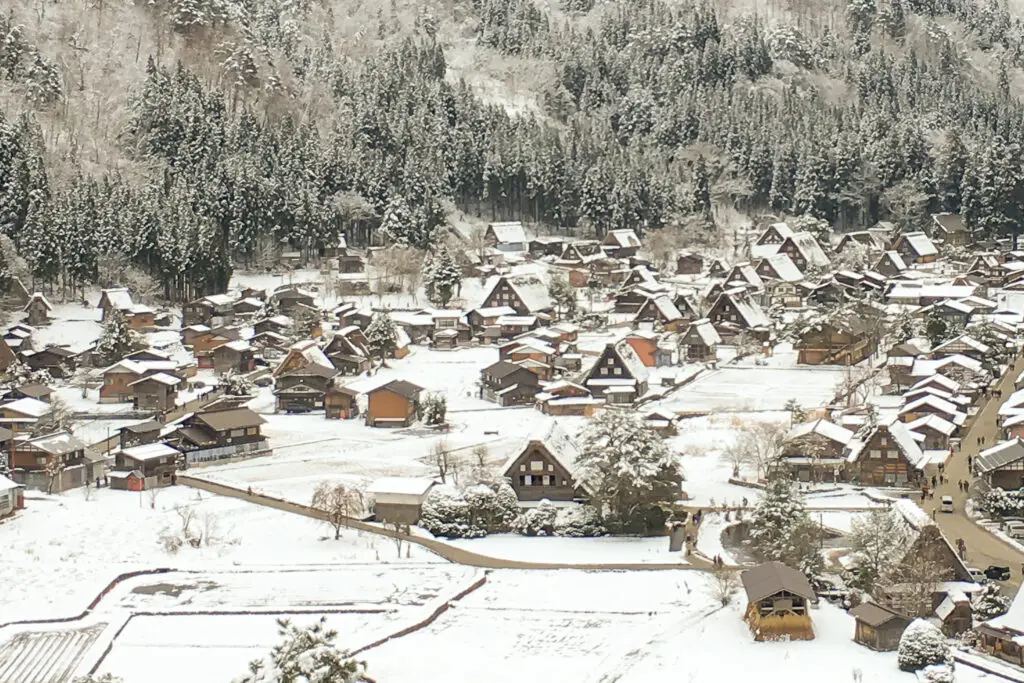
This is the best viewpoint to see the entire village from above. If you park at Shirakawa-go, it is a 30 minute walk to the viewpoint, which I highly suggest. It’s a nice walk, on a well paved path, between the icy trees.
Once at the viewpoint, you will see the small roofs in the village, cradled between the snowy mountains. It’s like looking into a real life Christmas snowglobe, and you may forget you are in Japan for a second.
Omigachi Open Air Museum
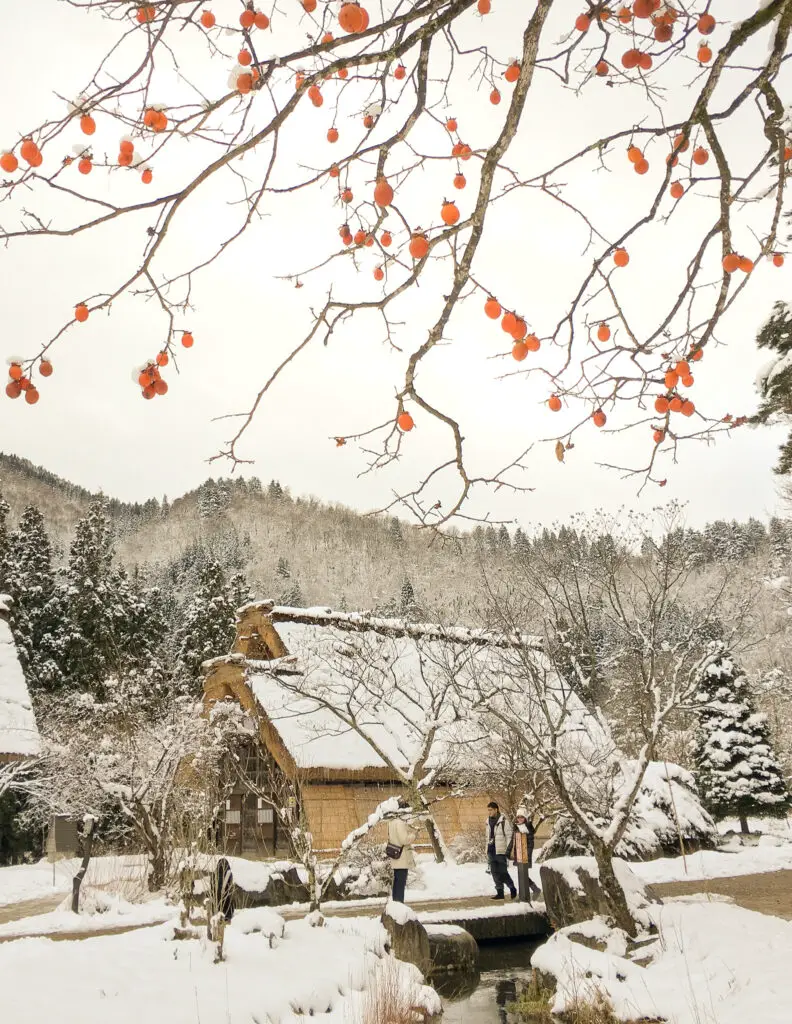
The enter village in Shirakawa-go itself is an open air museum. Here you can wander, and explore the many gassho houses.
The homes are well preserved, and there are load of historic items left, to tell the story of how the farmers of this region used to live.
Shirakawa-go no Yu Onsen
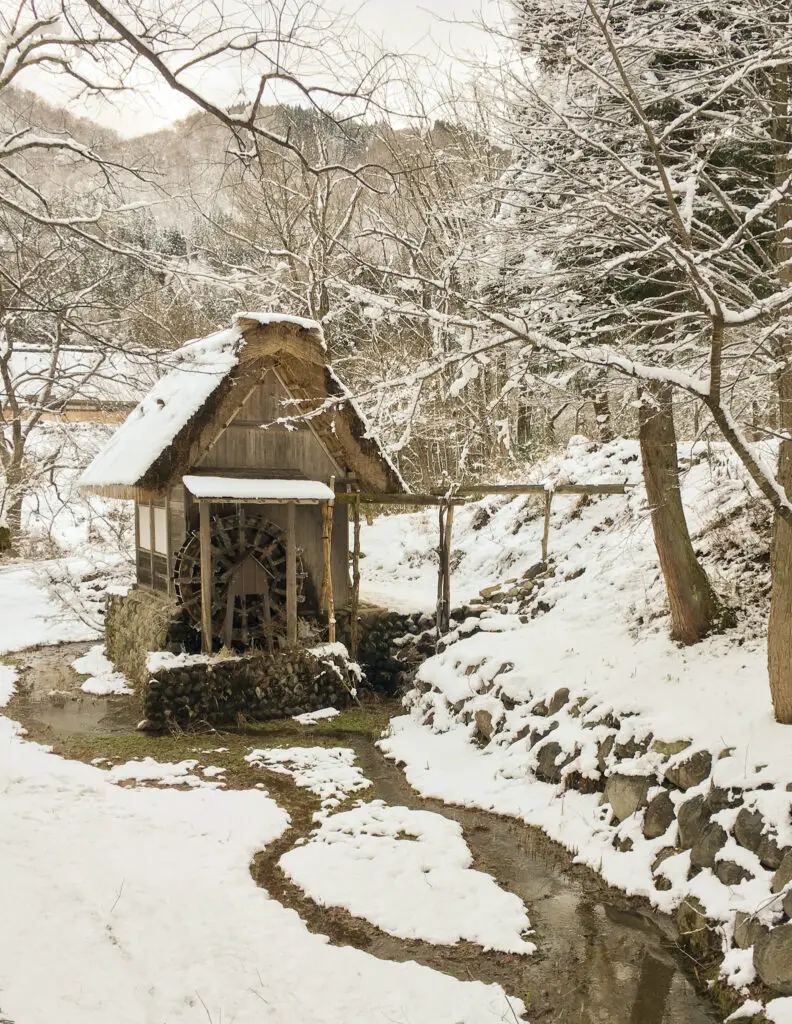
An onsen bath is an essential experience to add to your Japan bucket list, if you haven’t already.
This is the only onsen in the Shirakawa-go area. You can enjoy both the onsen indoors, or the open air bath. If you want, you can even stay overnight by booking here.
Myozenji Temple Museum
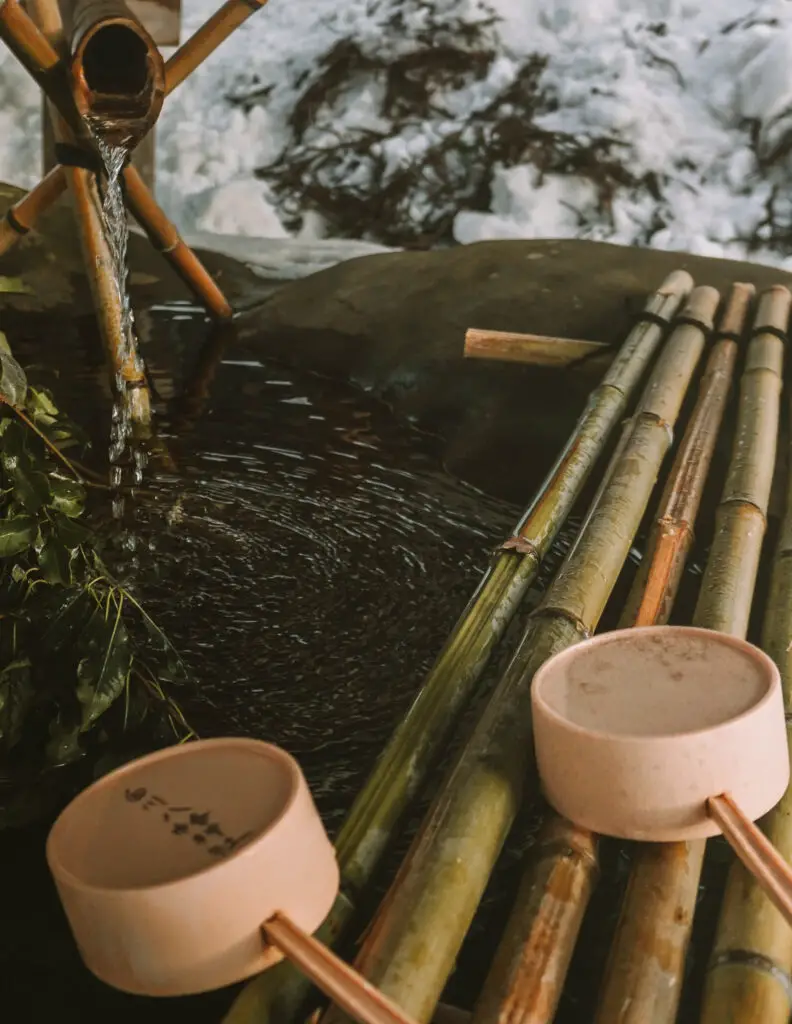
This temple was also a monks residence. It was built in the 1800s, and the housing structure retains its original appearance. Inside, there is a museum with artifacts and historical items from this region.
Entrance fee: 300 yen ($2.90 USD)
Stay for the Nightly Light Up
This event has recently become over-popular, and now requires advanced reservations to attend. You can find the schedule for the light up dates here.
For this event, they will light up the village from 5:30PM to 7:30PM on various nights throughout January and February. It’s a magical sight, but very crowded and very cold. Bring appropriate clothing if you plan to stay for this event.
What to Eat
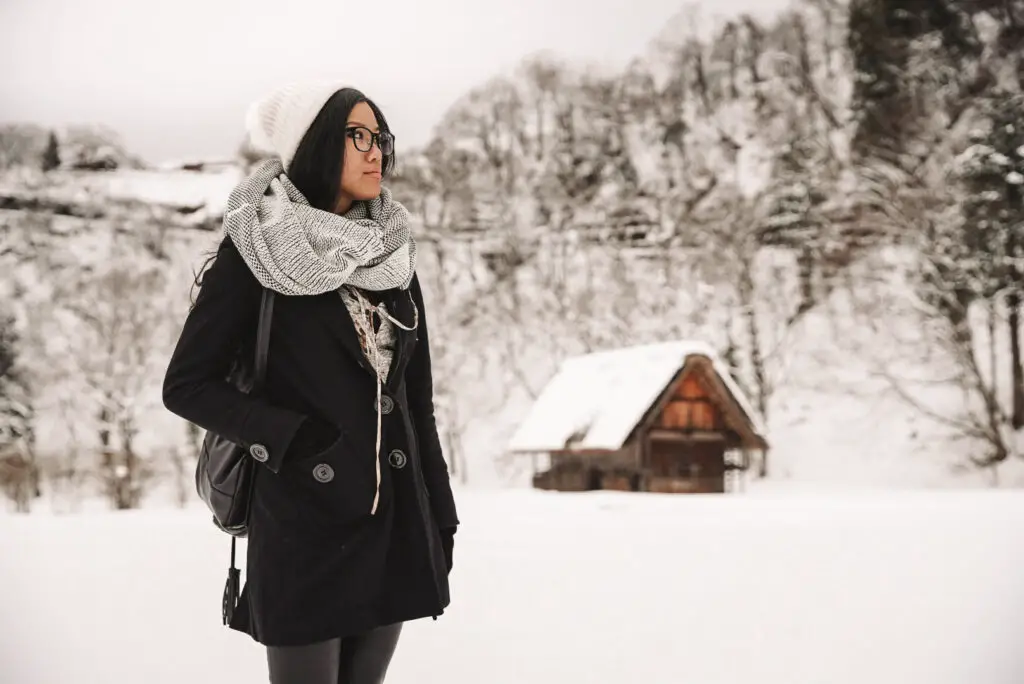
Street Food: Throughout the village, during the day, you will find several vendors selling hot snacks through a window. These are actually my favorite places to go for food. At Isanami, you can get ricecake or mochi balls on a stick, Other vendors, such as Hidaji, even sell beef croquettes and hot sake for take away.
Irori: This Japanese restaurant is located right in the middle of the village. At times, I saw a line going outside which is why I opted to have street food instead. If you make it in, they serve hot meals such as udon noodles and even some claypot dishes, perfect for a winter day!
Hanamizuki Shirakawa: Here you can get two of my favorite things in one: matcha green tea and soba! Soba is buckwheat noodles, a thicker and chewier noodle than ramen. Here, you can try matcha soba, if you feel adventurous.
Hakusuien: Here you can try Hida beef, a regional specialty produced in Gifu. Hida beef comes from black haired Japanese cattle, raised around the Hida area nearby. This restaurant serves their beef with traditional Japanese side dishes.
Where to Stay
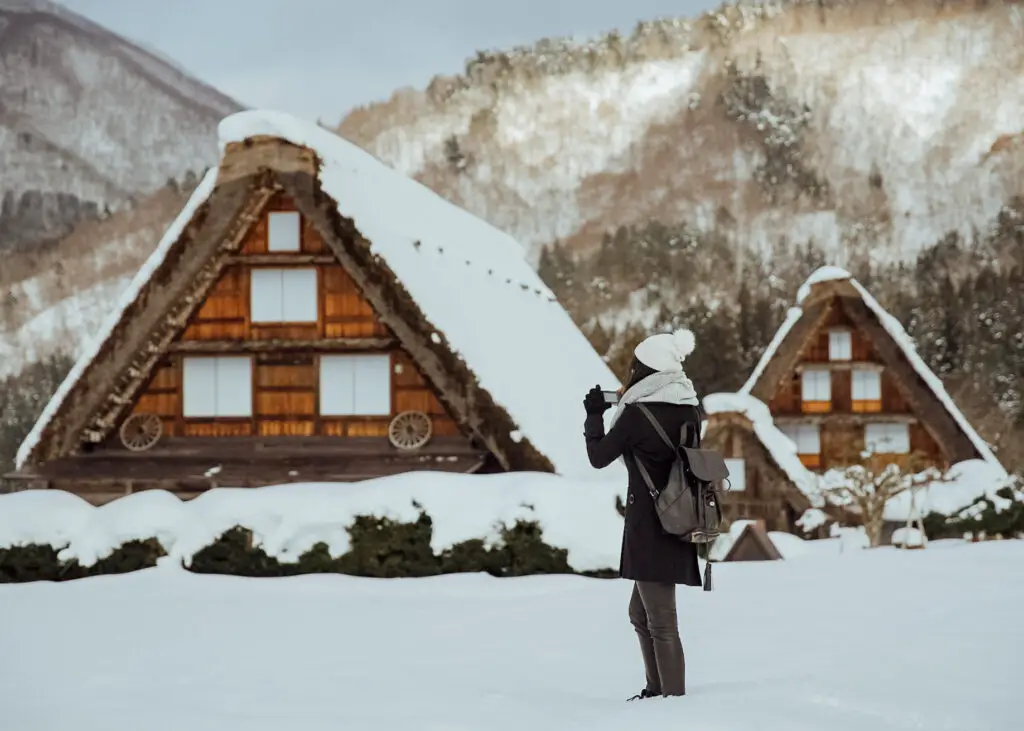
If you are looking for the ultimate experience in Shirakawa-go, you can opt to stay overnight one of the historic gassho-houses. While I think the concept of this is cool, keep in mind there is also nothing to do in Shirakawa-go at night.
If you stay overnight, it’s solely for the purpose of experiencing a night in your historic gassho-house, as everything else in the village closes after the tourists leave.
If this idea excites you, you can opt to book a gassho-house stay here. An overnight stay, will include a traditional dinner and breakfast, including regional dishes.
Since the last time I visited, Shirakawa-go has exploded in popularity. It is now difficult to book an overnight stay. If you want to try, you should book as far in advanced as possible, and maybe be flexible on your dates.
Other Tips
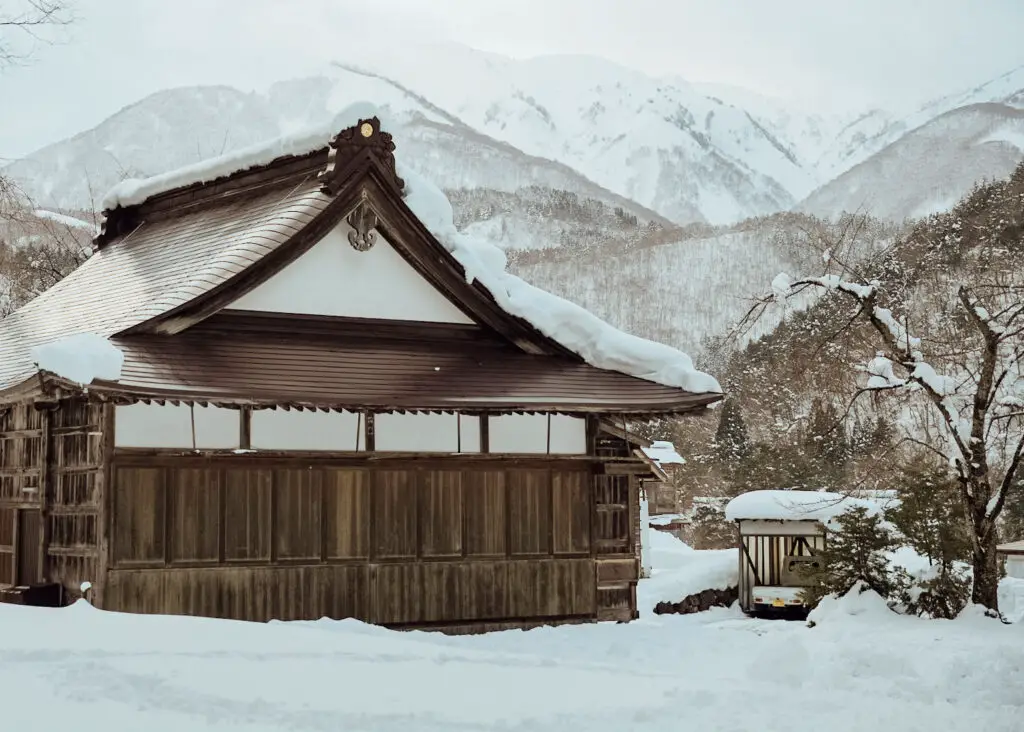
Japan Express Way Pass
If you will drive to Shirakawa-go, and rent a car in Japan in general, you should look into getting the Japan Express Way Pass. This pass will cover the cost of the toll booths.
You’d be surprised how expensive the toll booths are here. A 7 day pass is 20,000 yen ($190 USD), and if you plan to do a lot of long distance driving, this may be worth it.
Get a JR Pass
If you don’t plan to rent a car, the more common option is to use the train to get around. Japan is well connected, and the Shinkansen can get you from Osaka to Tokyo in 2 hours, instead of 10 hours of driving.
It’s very convenient, but expensive. The JR pass starts from 29,650 yen ($280 USD) for a 7 day pass. A one way trip from Osaka to Tokyo already costs 145,000 yen, so basically if you do more than 1 long distance trip in a week, the pass will save you money.
You can only order the JR pass before you arrive in Japan, so get it here in advanced.
What to Wear
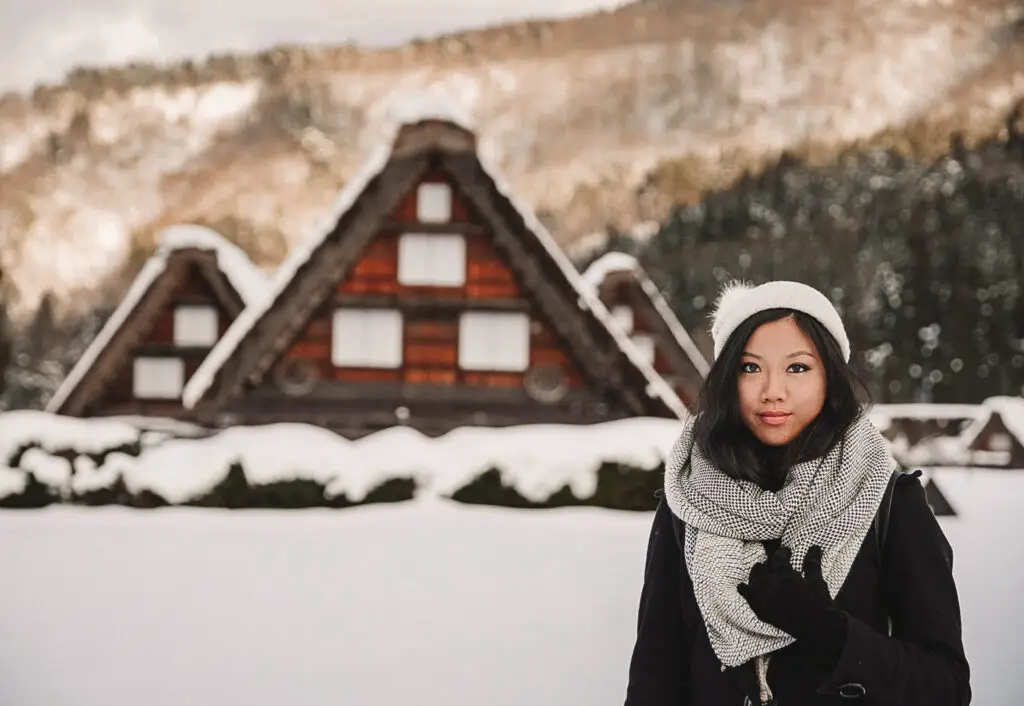
If you choose to visit Shirakawa-go in winter, the temperature will be between -6 and 5 degrees. It’s very cold in winter. I’d suggest wearing the following:
- winter jacket
- waterproof shoes
- a warm hat
- waterproof gloves
Other Places to Visit Nearby
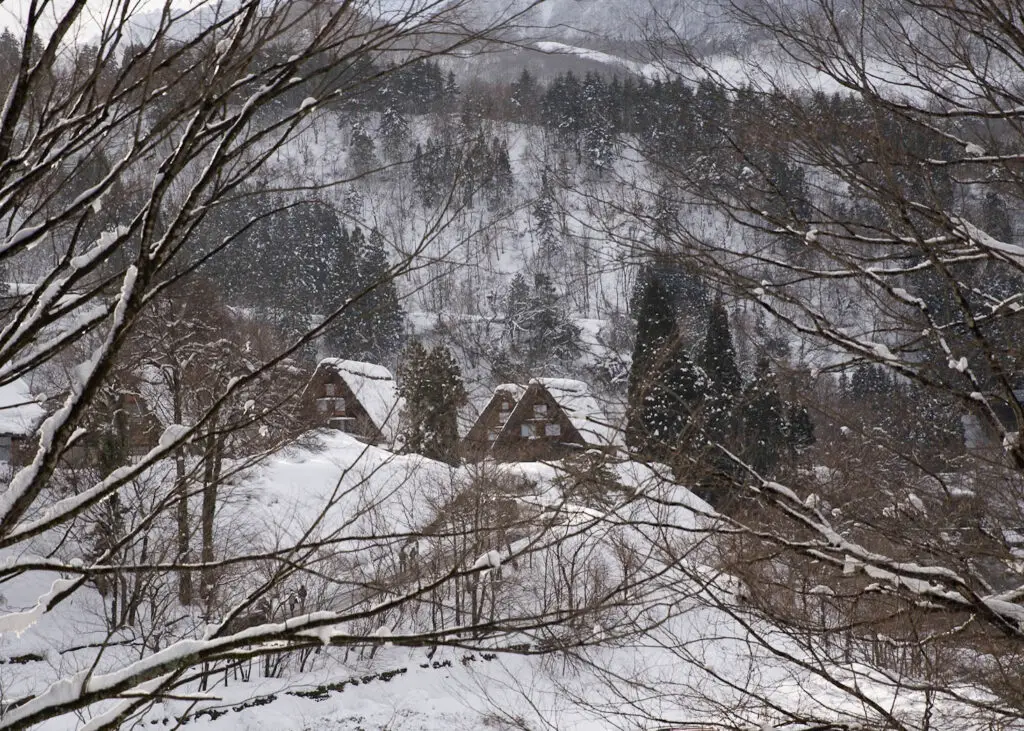
If you are already in Gifu, and want to continue your winter wonderland Japan tour, here are some places to check out on your trip:
Gokayama: Another traditional village with gassho style huts. While it’s actually in Nanto prefecture, its not far fro Shirakawa-go.
Hida-Takayama: A Japanese town with a well preserved old town. You can get a feel for a past Japan here, and it’s the place to be to try regional sake and hida beef.
Gero: If you love hotsprings, this is a popular onsen town for Japanese people. I don’t see many foreigners here, but I take my family here every trip since they love onsens. There are even public outdoor baths here by the river.
And there you have it! The complete guide on how to visit Shirakawa-go in winter. What’s your favorite place in Japan? Let me know below.
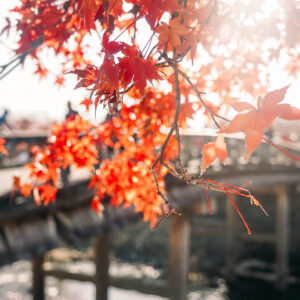 The Best Places in Kansai Japan in Autumn
The Best Places in Kansai Japan in Autumn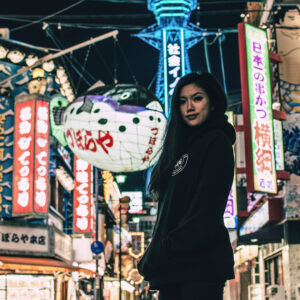 Best Things to Do in Osaka in 2023: Tips from a Local
Best Things to Do in Osaka in 2023: Tips from a Local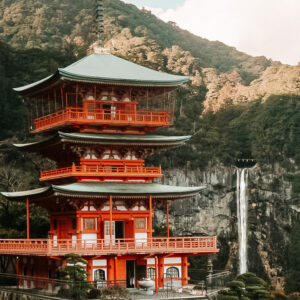 How to Hike Kumano Kodo: Japan’s Ancient Pilgrimage Trail
How to Hike Kumano Kodo: Japan’s Ancient Pilgrimage Trail Hokkaido in Summer: Guide to Japan’s Northern Treasure
Hokkaido in Summer: Guide to Japan’s Northern Treasure


What a beautiful spot! I never think of snow and Japan so this was great to read.
Oh my gosh, this is RIGHT up my alley! I had to cancel a trip to Japan this March and am dying for things to open up for that I can finally go. Living in South Korea, it’s quite easy to visit Japan (and flights are so cheap!) so this is HIGH up on my list. Will save this guide for next year!!!
wow, I never knew about Shirakawa-go, what an awesome place, and those photos are absolutely splendid. Definitely adding this place to my list, thanks for that! 🙂
Here, you can discover lots of casino slots from top providers.
Users can enjoy classic slots as well as new-generation slots with high-quality visuals and exciting features.
Whether you’re a beginner or a casino enthusiast, there’s something for everyone.
casino
Each title are instantly accessible round the clock and designed for desktop computers and tablets alike.
You don’t need to install anything, so you can get started without hassle.
The interface is easy to use, making it simple to browse the collection.
Sign up today, and enjoy the world of online slots!
Сайт BlackSprut — это довольно популярная онлайн-площадок в даркнете, предлагающая разные функции для всех, кто интересуется сетью.
На платформе реализована удобная навигация, а интерфейс не вызывает затруднений.
Гости выделяют отзывчивость платформы и постоянные обновления.
bs2best
Сервис настроен на комфорт и анонимность при навигации.
Тех, кто изучает инфраструктуру darknet, этот проект станет удобной точкой старта.
Перед началом лучше ознакомиться с основы сетевой безопасности.